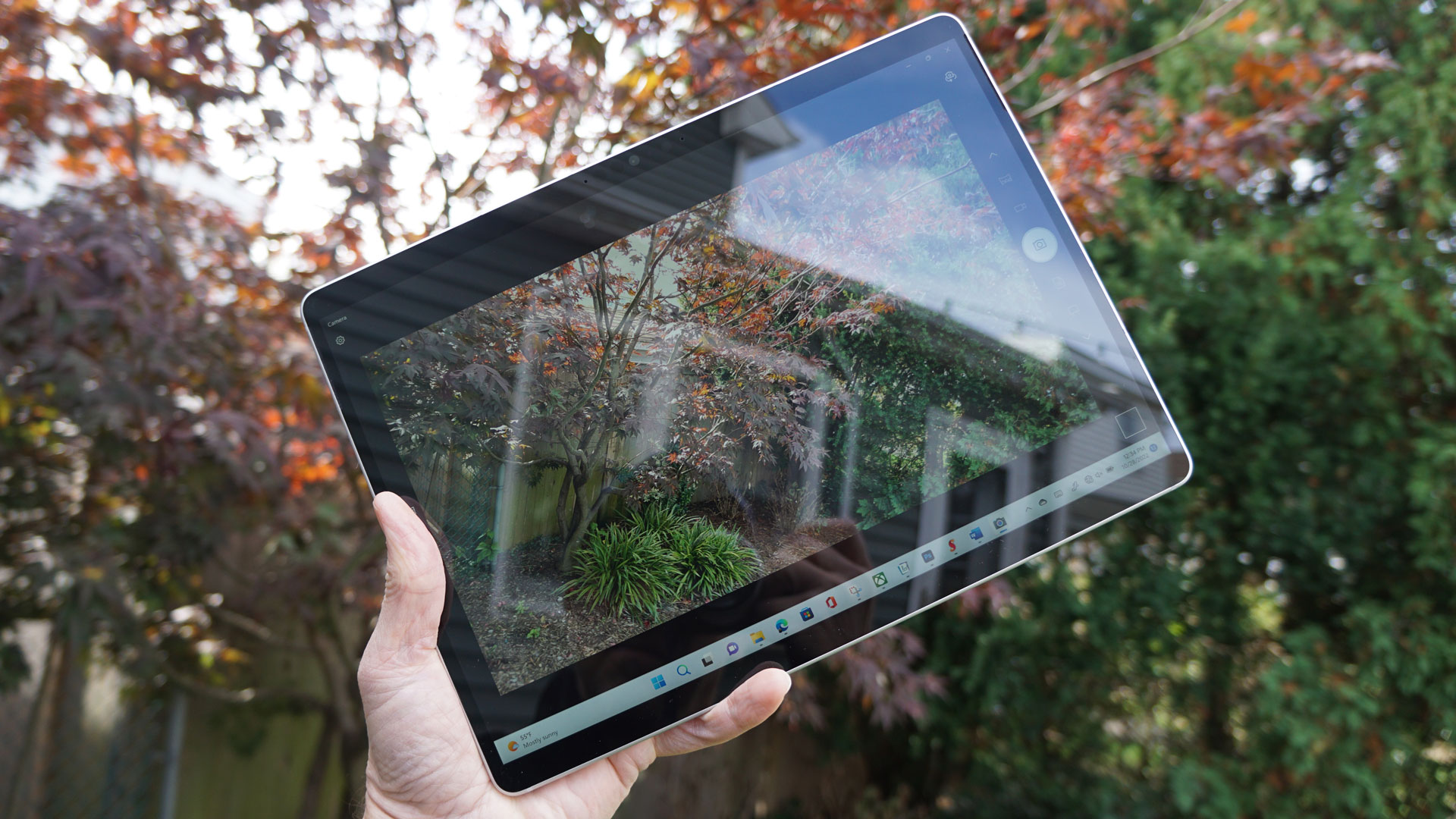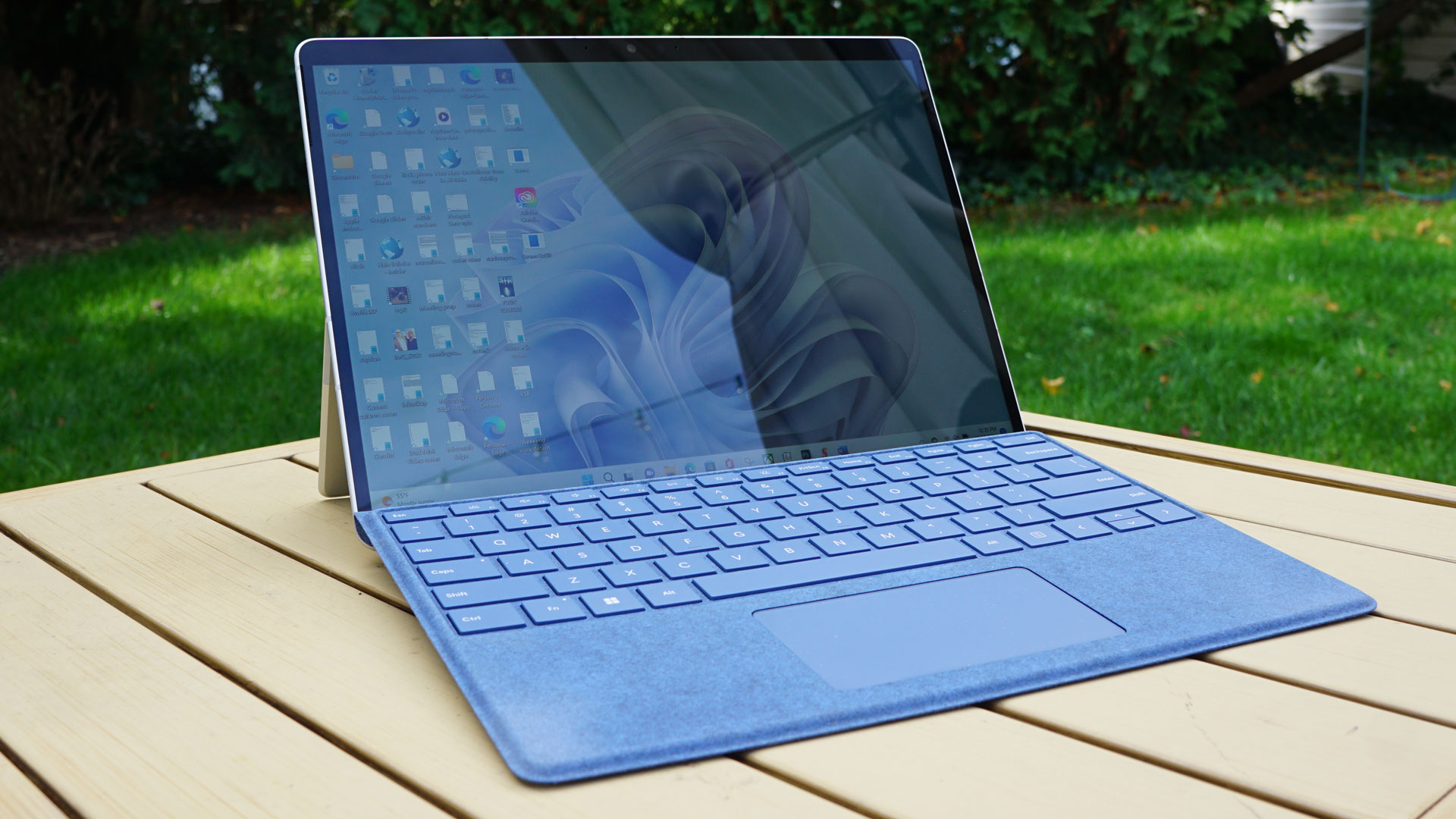
Editor's Note
• Original review date: April 2023
• Launch price: Starts at $1,299 / £1,299 / AU$2,599
• Target price now (updated model): $999.99 /£1,049.99 / AU$1,899.99
Update – August 2024: The Surface Pro 9 5G was a venerable device, but it now lies defeated; completely superseded by the new Microsoft Surface Pro 11, which is a superior device in virtually every way thanks to the powerful new Snapdragon X Elite chip powering it.
It's not exactly hard to find the Surface Pro 9 5G model these days, but pricing is completely all over the shop - and frankly, there's zero reason to recommend it now that the Pro 11 is here, and cheaper for the base configuration to boot as you can see from the above pricing.
The Pro 9 5G failed to make the list of our best ultrabooks due to compatibility issues with Windows on Arm (since it used a Microsoft SQ chip rather than a conventional x86 or x64 processor), but with the advancements made in the WoA space thanks to Qualcomm's new Snapdragon chips, that's no longer such a concern - and the new model absolutely rules.
Original review follows.
Microsoft Surface Pro 9 5G: Two-minute review
You don't review a laptop such as the Microsoft Surface Pro 9 5G (or indeed any product) in a vacuum. You have to look at it from the perspective of what came before, what else is available in the market, your experience with the product, and, in our case, our long-time association with Surface gadgets.
This reviewer has been using Surface devices since Microsoft introduced them a decade ago. It's been a journey of mostly (but not always) incremental changes, many of which ensured that legacy users wouldn't be left behind. Even when Microsoft unveiled the mold-breaking Surface Pro X, it kept the OG Surface design chugging along with the Surface Pro 7.
That changed with last year's Surface Pro 8, which adopted the Pro X look for the Intel platform and was Microsoft's first USB-3-free Surface Pro device.
Microsoft's Surface Pro 9 5G takes the strategy a step further by applying the Pro brand to an ARM-based system while retiring the Pro X line. It also makes a further break with the past by dropping the 3.5mm headphone jack (a moment of silence, please).
In general, this is a winning formula. Microsoft has all but perfected the Surface Pro X design for a wider Pro-grade audience. It's a thin and sturdy Windows tablet with an expansive screen that provides all the space and visual performance you need for productivity, creativity, and consumption (it's a nice Netflix screen).
As a 5G system, the Surface Pro 9 5G stands ready to keep you connected at home and on the go without the need for a Wi-Fi connection.
The ARM system brings some neural engine-based tricks you won't get with the Intel model, such as eye tracking, gaze correction, noise suppression, and better background blurs that can blur multiple people at once. It's all mostly trouble-free, but there were hiccups, including a complete collapse of our Adobe Creative Cloud Photoshop and too many Microsoft Edge crashes.
You will pay dearly for Microsoft's most road-ready Surface Pro. The Microsoft Surface Pro 9 5G starts at $1,299.99 and that's without the Surface Pro Signature Keyboard and Slim Pen 2, which we consider critical additions to the Surface Pro 5G package and that will add another $279.99 to the package.
Ultimately, there is a lot to love about the Microsoft Surface Pro 9 5G but inconsistent operation and an eye-popping price might keep it off of our Best Laptops list.
Microsoft Surface Pro 9 5G: Price and availability
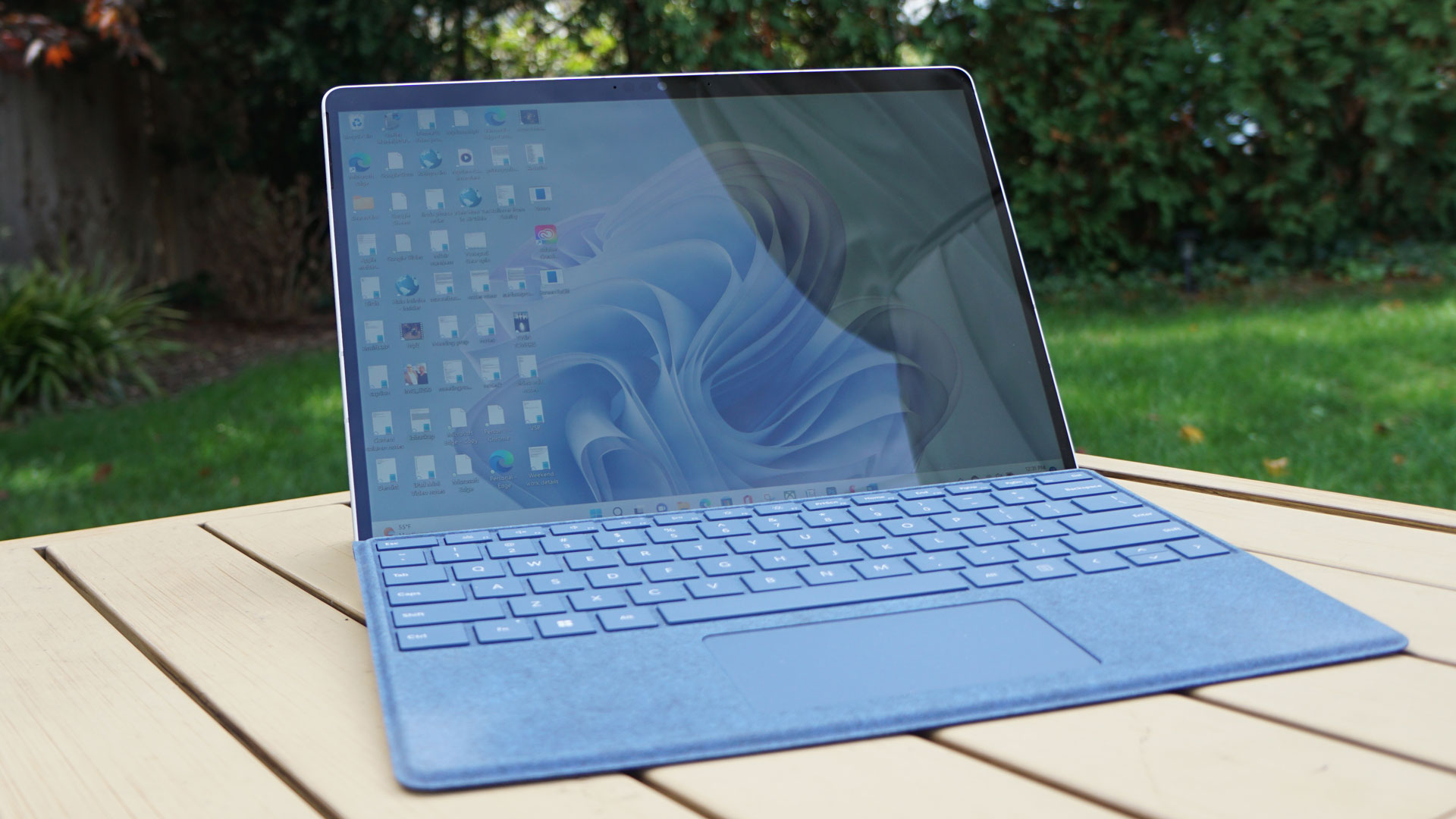
- How much does it cost?
- $1,299 / £1,299 Microsoft SQ3 5G Platinum, 8GB RAM, 128GB SSD
- $1,399 Microsoft SQ3 5G Platinum, 8GB RAM, 256GB SSD
- $1,599 / £1,599 / AU$2,599 Microsoft SQ3 5G Platinum, 16GB RAM, 256GB SSD
- $1,899 Microsoft SQ3 5G Platinum, 16GB RAM, 512GB SSD
- When is it out? It is available now
- Where can you get it? Surface Pro 9 went on sale on October 25th in the US, Canada, and China, with additional markets to follow in the coming weeks. Check Microsoft.com for updates on local availability.
Here is the Microsoft Surface Pro 9 5G configuration sent to TechRadar for review:
CPU: Microsoft SQ3 3.00 GHz
Graphics: Adreno™ 8CX Gen 3
RAM: 16GB DDR4 RAM
Screen: 13″ 2880 x 1920 PixelSense Flow Display
Storage: 256 GB
Ports: 2 x USB-C® with USB 4.0/ Thunderbolt™ 4, Surface Connector Port; Surface Type cover port
Connectivity: WiFi 6E, Bluetooth v5.1
Camera: Front-facing 5MP Camera with 1080P full HD video, 10MP read camera with up to 4K video support
OS: Windows 11 Home
Weight: 883 g (1.95 lbs)
Size: 209 x 287 x 9.3mm (W x D x H)
Battery: 47.7Whrs with 65W AC Adaptor
Microsoft's Surface line has never been what you might call an affordable option. That probably didn't matter much as Microsoft was leading the PC industry out of the wilderness to new design and market opportunities. Things are a bit different now, with many of the biggest names in PCs producing beautiful convertibles that either reflect or outdo what Microsoft has to offer. Plus, there's the cost-of-living crisis to consider. Who will be willing to splurge nearly $1,500 for a laptop?
The base Surface Pro 9 starts at $999 / £1,099 / AU$1,649 (without the Surface Pro Signature Keyboard and Slim Pen 2 - another $279). The Surface Pro 9 5G, which adds mobile connectivity and some cool neural-powered capabilities, starts at $1,299.99 / £1,299. In Australia, the Surface Pro 9 5G starts with more RAM (16GB, AU$2,599).
That's quite a premium for what may not be that much more utility. It really depends on how deeply you cherish constant connectivity and some AI capabilities. Plus, that has to be balanced with a subsystem that may or may not fully support your business-class software.
- Value: 3.5 / 5
Microsoft Surface Pro 9 5G: Design
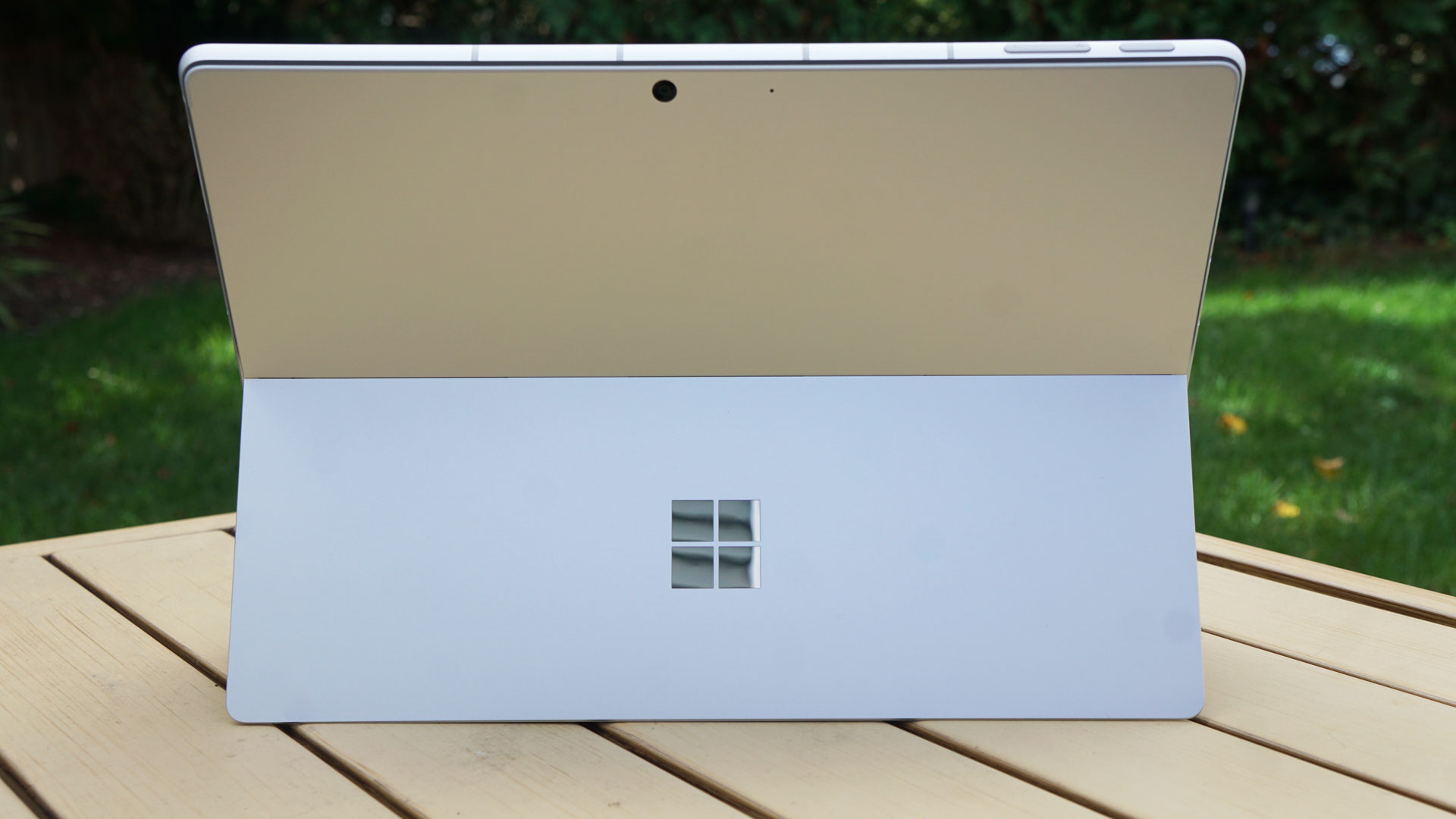
- Lightweight aluminum casing
- Smarter placement of buttons
- Two high-speed USB-C ports
- No 3.5mm headphone jack
For those who spent the better part of a decade using various Surface Pro devices, the Surface Pro 9 5G (and Surface Pro 8 before it) is a mix of mostly good news and a little bad.
The good news is that the 13-inch screen is significantly larger than that of, say, the Surface Pro 7, which measured 12.3 inches. However, the redesign of the Surface Pro series has resulted in a larger and slightly heavier device.
Its 287mm x 209mmx 9.3mm aluminum (formerly magnesium) body is wider and thicker than the Surface Pro 7 (292mm x 201mm x 8.5mm). And, at 878g, it's 13 grams heavier.
None of this is particularly noticeable and we'd suggest the minor bulk increase is well worth it, considering the more expansive screen.
It's a similar design to the last model, with a kickstand that can smoothly rotate until it's almost flat against the upper half of the convertible. That smooth motion makes it easy to find a perfectly "lappable" position.
The differences between the Surface Pro 9 and Pro 9 5G chassis that we're testing are minimal, but worth nothing. Whereas the Intel model has actual vent holes in the uniform ventilation channel running around the body, the fanless SQ3 model only has the channel. While there was no indication of our system overheating, the back of the Surface Pro 9 5G did get noticeably warm to the touch during normal operation.
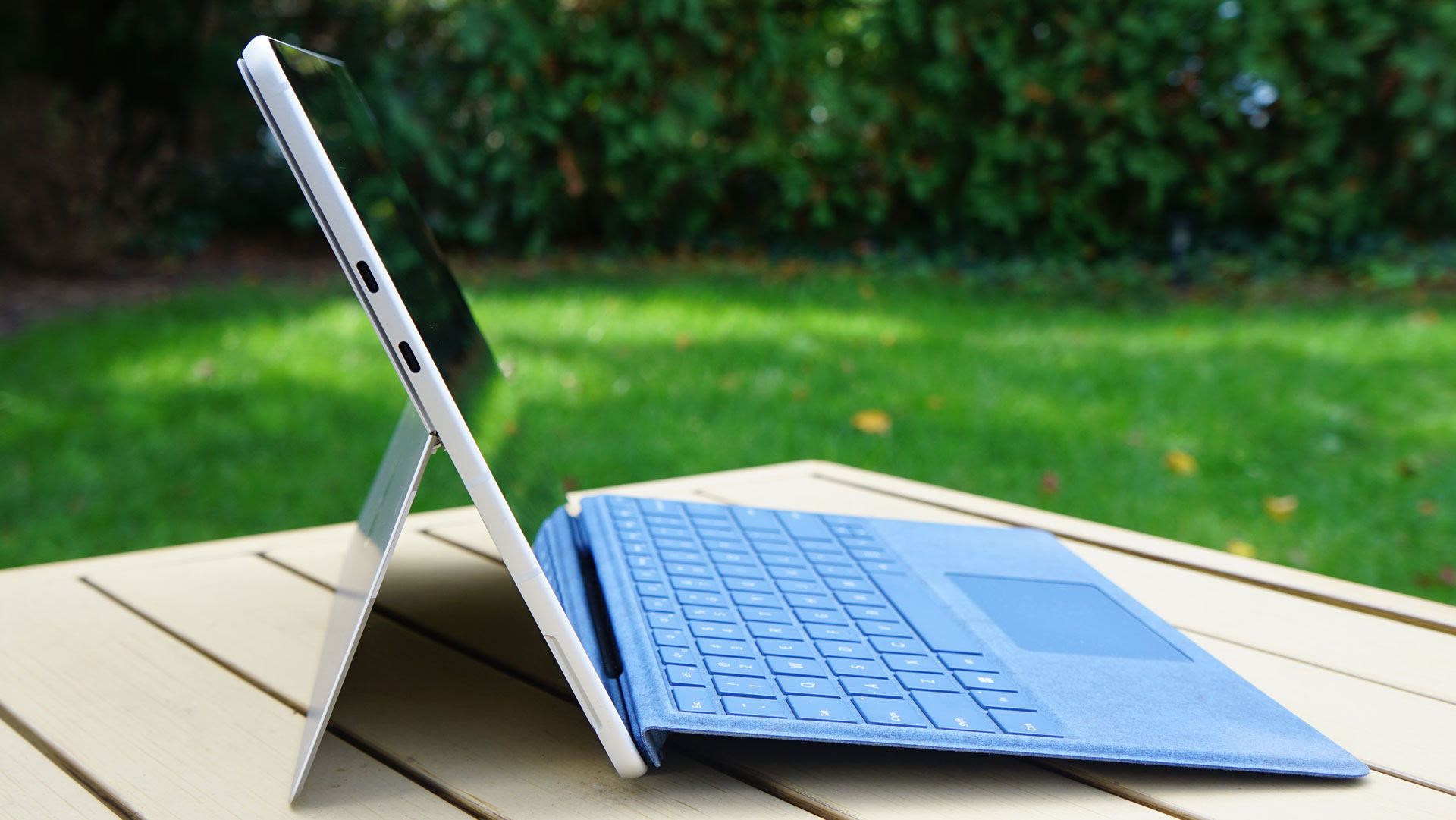
Microsoft has shuffled the buttons and ports a bit since the Surface Pro 8. There's no more 3.5mm headphone jack, which may bother some who invested in either affordable earbuds or more expensive over-the-ear headphones that still use the port.
The system's two USB ports have shifted from the same side as the Surface Connector power port to the opposite side of the unit, where they have the space to themselves. Microsoft smartly repositioned the power sleep button from the side back to the top of the Surface Pro 9 5G (a space it occupied on all previous Pros up to the Surface Pro 8) and next to the volume rocker button.
The other difference between the Surface Pro 9 and its 5G counterpart is the antenna cutouts, which are at roughly 1.5-inch intervals to enable mmWave 5G.
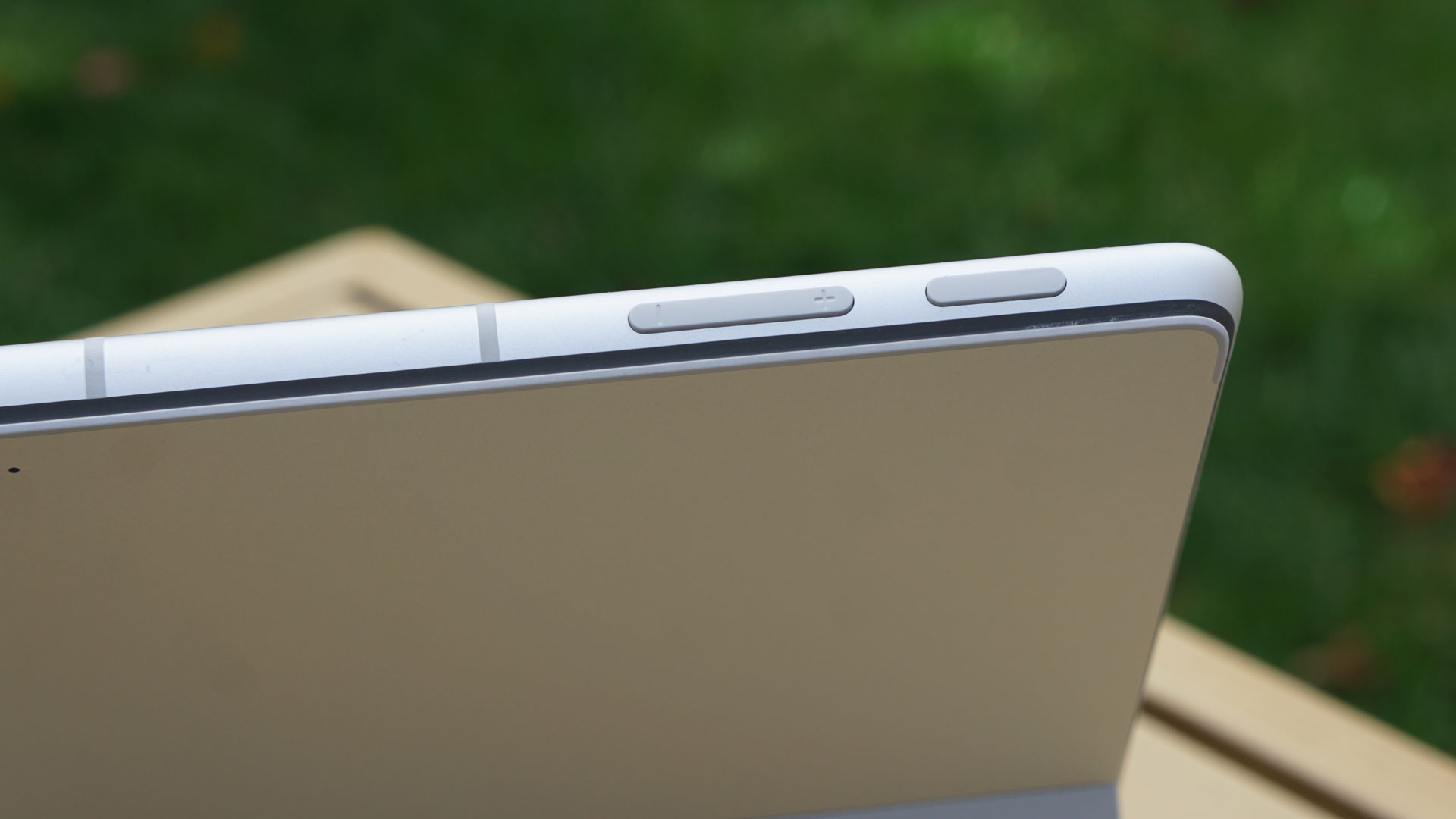
Even though the Microsoft Surface Pro 9 5G doesn't ship with the Surface Pro Signature Keyboard Cover and Slim Pen 2, we're reviewing them as a package. As such, we'll talk about the combined design of the tablet, keyboard, and pen here. As we noted above, the keyboard and pen combo list for $279 / approximately £294.28 / AU$386.95.
For us, the Signature Keyboard Cover is an indispensable companion for the Surface Pro 9 5G package.
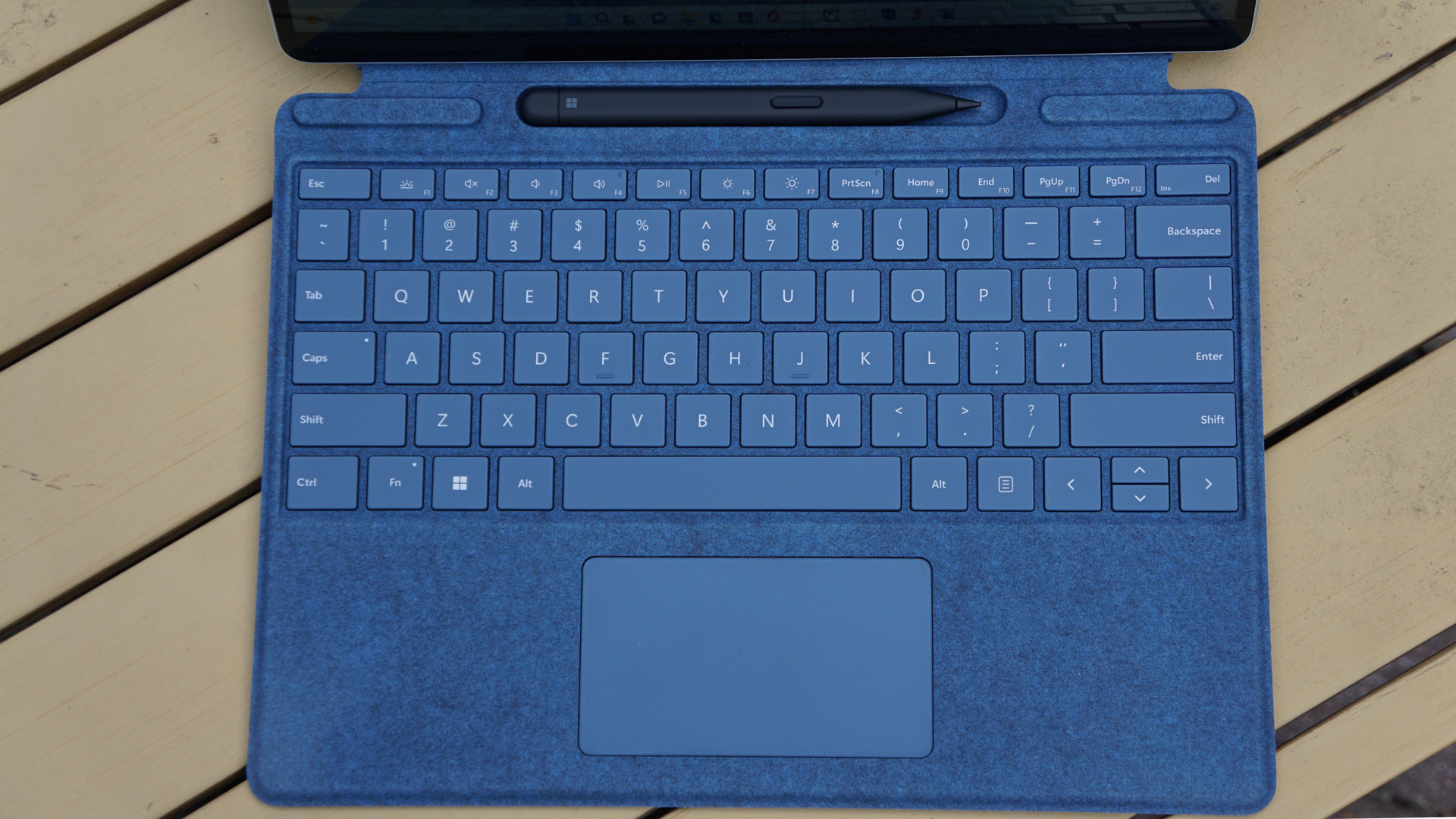
At 10.75 inches wide, the keyboard is essentially full-sized and offers comfortable spacing between the keys plus 1.5mm of travel on a per-key basis for a satisfying type feel. The Alcantara cover makes for a comfortable palm rest and below the keys is a thumb-reachable and expansive 4-inch wide touchpad.
Microsoft re-engineered the type cover attachment system with the Surface Pro X to create a craftily hidden cubby for the Slim Pen 2. Instead of the pen using strong magnets to hug one side of the Surface Pro, this Pen has its own magnetized recharging bed that's hidden away when a half-inch of the type cover hugs the bottom of the Surface Pro 9 5G screen. The two components marry along the bottom edge of the Surface Pro 9 5G, which features a Surface Type Cover port.
To reveal the pen, we just pull the keyboard away from the screen and pluck out the Pen. It's always fully charged and ready to use with a pen-friendly display.
Overall, this is a more elegant and secure way to manage the pen.
- Design: 4.5 / 5
Microsoft Surface Pro 9 5G: Cameras and Audio
- Great camera for video conferencing
- Unlock with your face
- Good-enough rear camera
- Great mics
- Good audio
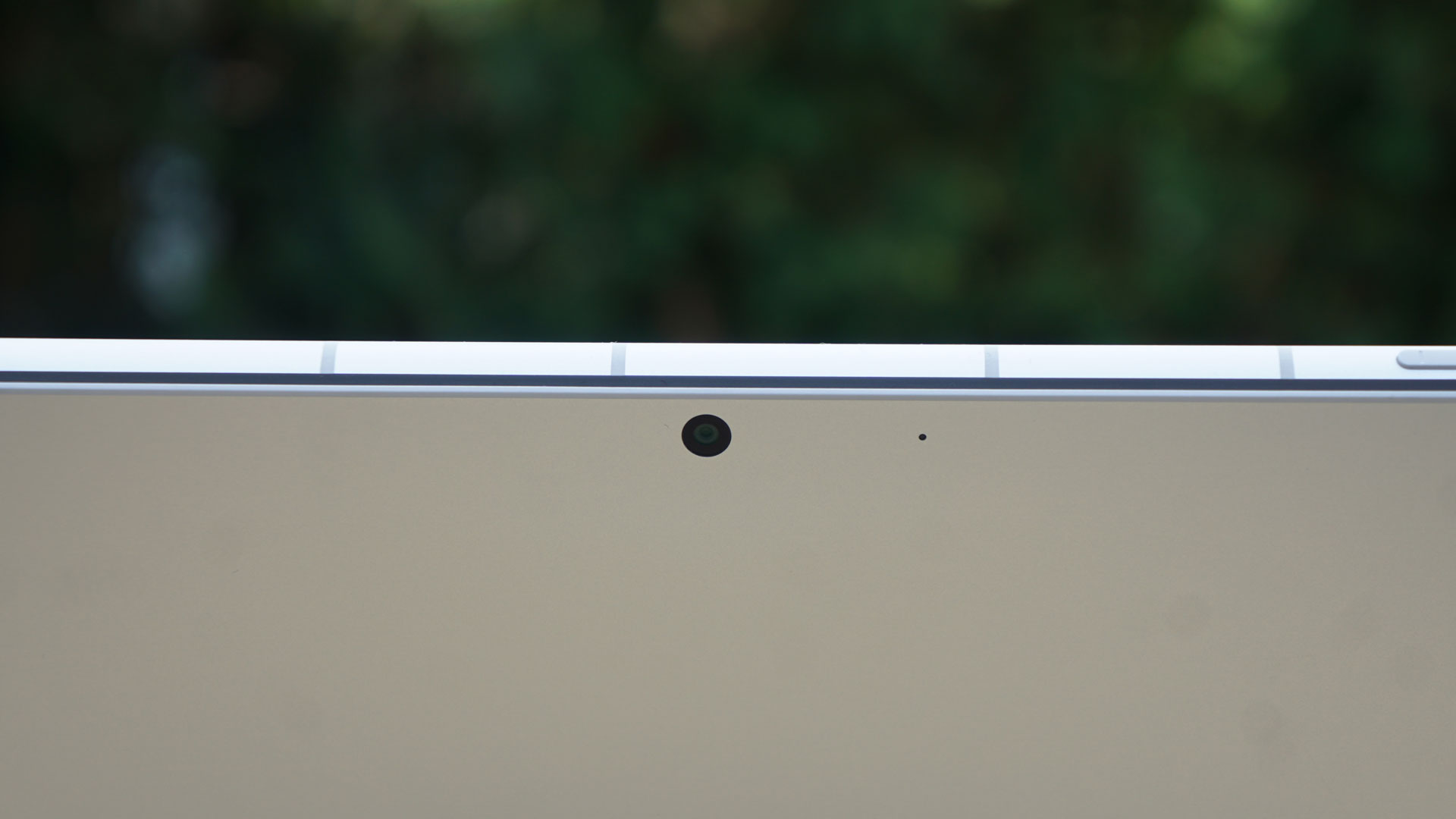
One thing Surface Pro devices have long excelled at is video conferencing, not least because they had 1080p-capable front-facing cameras long before the competition. This author often got complimented on the quality of his video feed on Surface Pro 6 and Surface Pro 7. The Surface Pro 9 5G is no exception.
The front-facing camera is still 1080p and does an even better job of making you a video call champ. On this SQ3-based model, the AI, if you enable Windows Studio Effects, keeps you in the frame by shooting wide then moving the frame around to keep you in the picture. It also makes your eyes appear as if they are still focused on the camera even when they're not, and offers better bokeh effects that can keep multiple people in the frame unblurred.
What's more, it's also supported by dual far-field microphones, which means no one will have any trouble hearing you, while the SQ3's neural engine brings special background noise-canceling capabilities.
Next to that camera is the Windows Hello camera, which we recommend setting up. It lets you unlock your computer with your face and is highly secure (it can't be fooled with a picture).
The rear of the device offers the same 10MP shooter as the last model. It creates decent if unexceptional images. It can also shoot 4K video, though we wonder how often people are shooting hand-held video with their Surface laptops.
There are also a pair of 2W Dolby Atmos-supporting stereo speakers that provide robust, clear sound. They're good for meeting audio. If you're not working, the speakers provide an excellent aural companion to any action-packed Netflix video.
- Cameras and Audio: 4/5
Microsoft Surface Pro 9 5G: Display and Pen
- Increasingly classic LCD screen
- Good for touch and pen
- 13-inch is the just-right size
- An excellent, ergonomic pen
Even though Microsoft has yet to upgrade its PixelSense screen technology to OLED or MicroLED, the screen is undeniably one of the better mobile work and design displays in the business.
That's because, despite that lack of core tech change, this screen offers dynamic 120Hz and a high resolution of 2880 x 1920 (267 ppi), among other things. To put that in perspective, the mini-LED-based Liquid Retina XDR display found on the Apple iPad Pro 12.9, which is also capable of 120Hz, has a resolution of 2732 x 2048, and offers a slightly lower 264 ppi.
When it comes to brightness and contrast, the Surface Pro 9 5G doesn't compare favorably to the aforementioned iPad Pro 12.9. It has a max brightness of 450 nits (iPad Pro 12.9 has a max of 1,600 nits) and a contrast ratio of 1200:1 (iPad Pro 12.9 promises 1,000,000:1).
The relative lack of brightness means that the Surface Pro 9 5G might not be the best outdoor work companion, but at home and in the office, you probably won't notice that difference any more than you will the contrast ratio differences. Naturally, some of these specs might give creative professionals pause. Even so, drawing, editing, browsing, and working in production apps never suffered during our testing.
Of course, it also has the benefit of being both a touch- and pen-friendly screen.
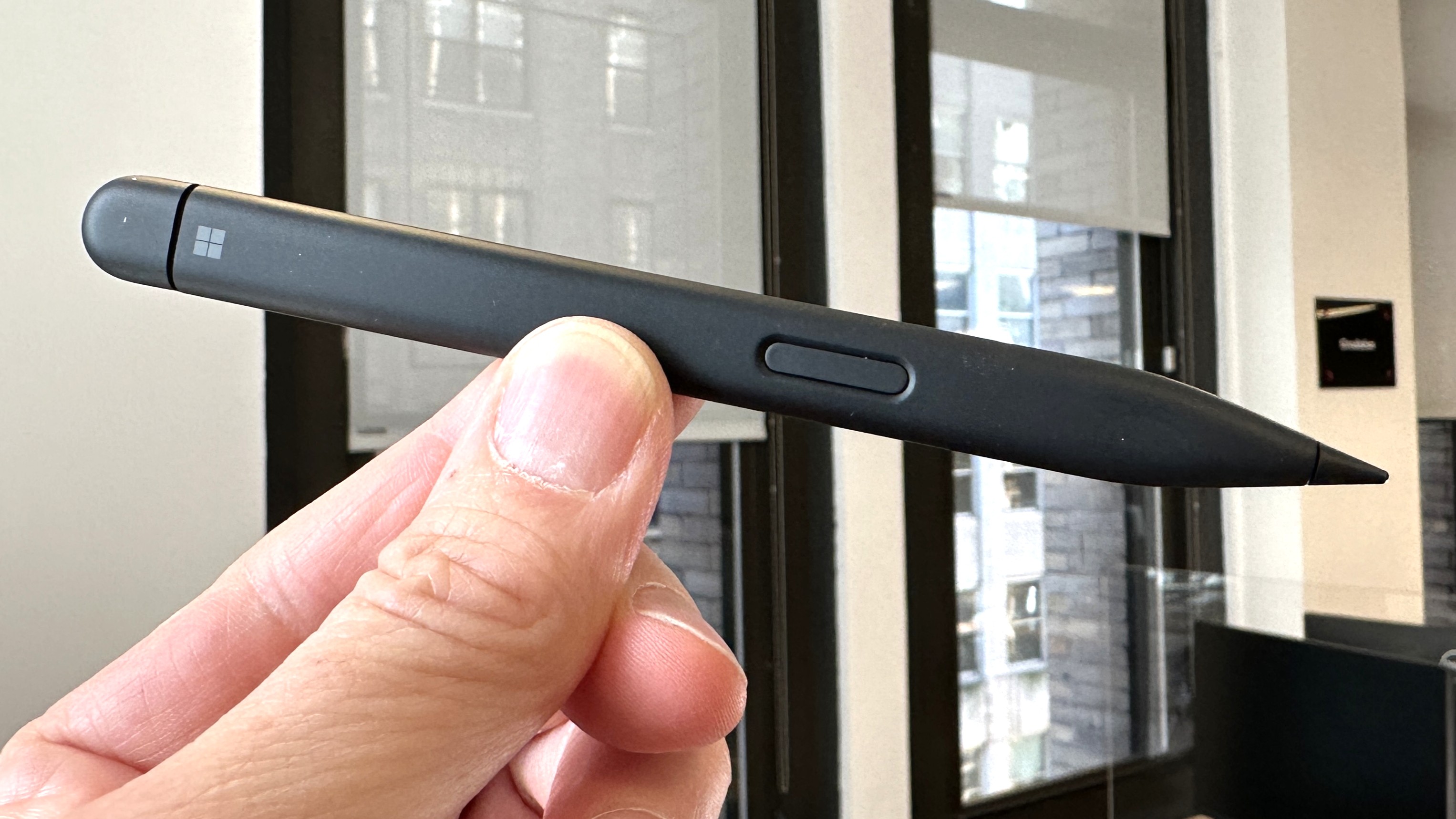
We've long become accustomed to occasionally tapping the screen to select something on a Surface device and highly recommend picking up the Slim Pen 2 for both artistic and note-taking pursuits.
Not only does it look as if black ink is flowing out of the tip of the beautifully designed Slim Pen 2 and onto the screen, but the latest Pen offers even more precise haptic feedback to make it feel as if you're scratching a pencil across real paper.
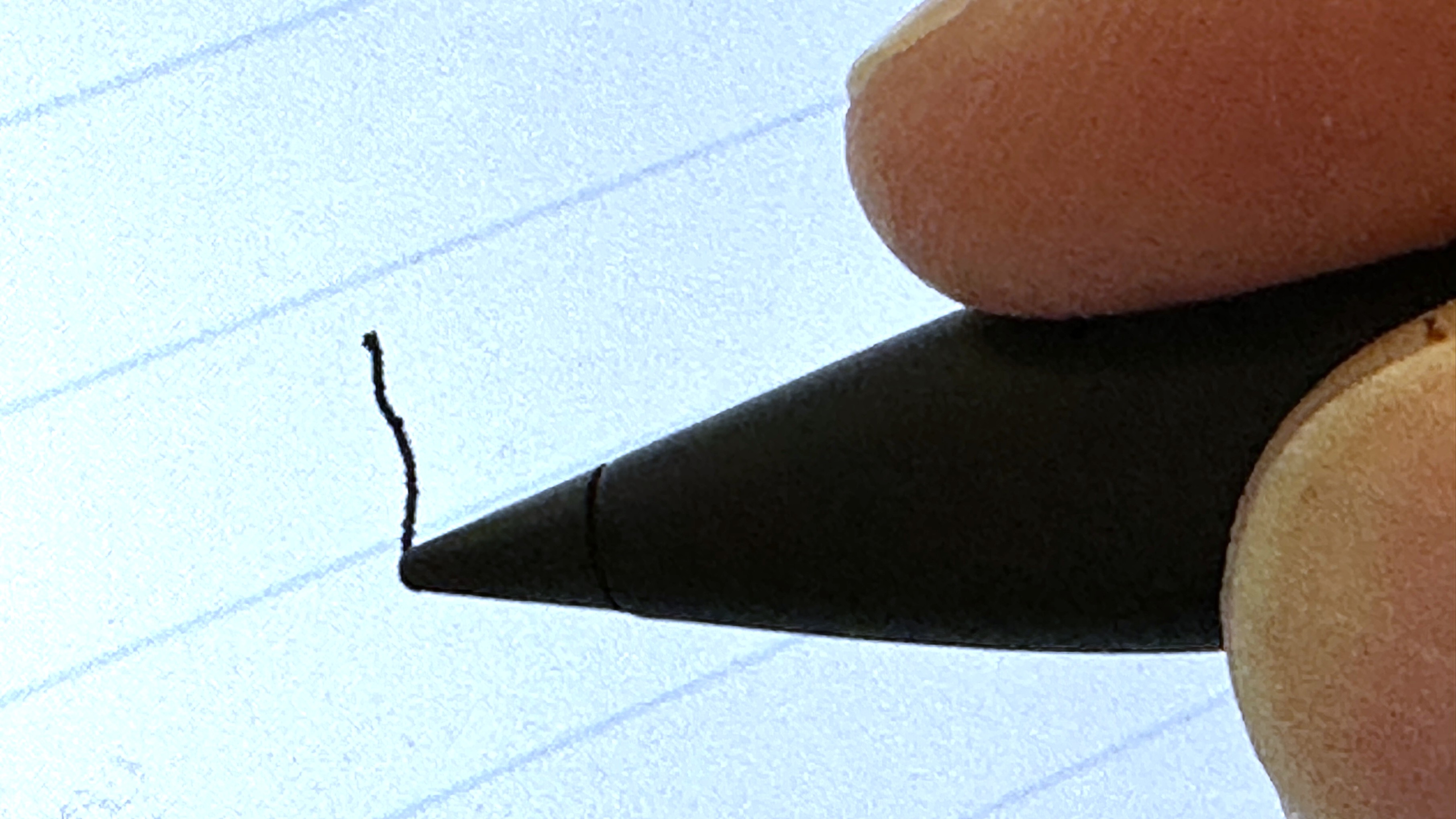
Aside from that haptic tweak, the Slim Pen 2 is no different than the one found on the Surface Pro 8, and that's fine with us. We like the drafting pen design, which is lightweight, comfortable to hold, and never slips from your grip.
Unlike an Apple Pencil 2, Microsoft's Slim Pen 2 makes use of both ends of the digital writing implement. There's the business side, which is as useful for drawing in Sketchable as it is for journaling in Journal, and then there's the eraser side, which is both a button and a digital eraser. There's also a button along the pen body that you can use to activate various features in a number of apps. In Sketchable, for instance, it can be used to quickly access the eye-dropper color picker.
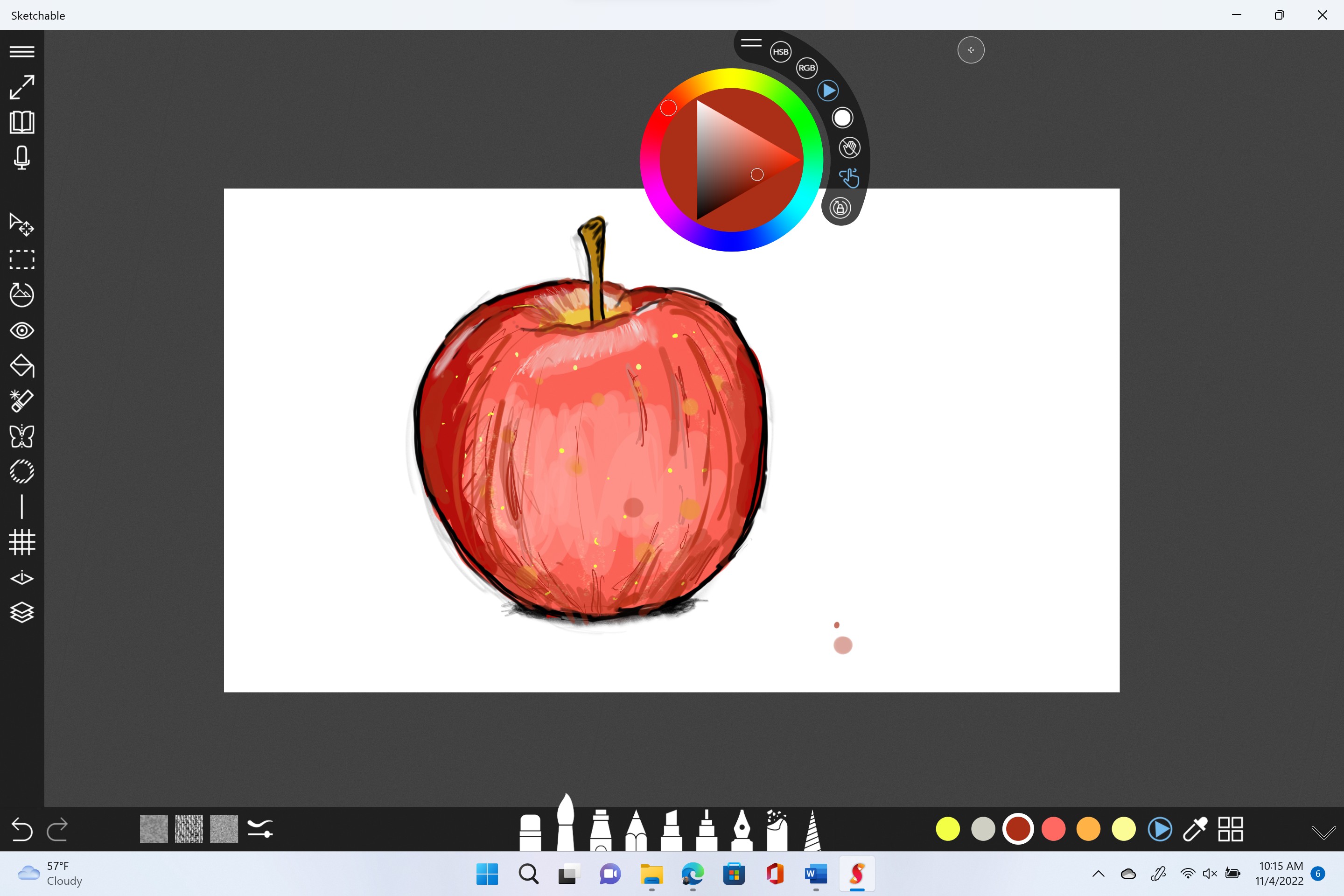
- Display and Pen: 4/5
Microsoft Surface Pro 9 5G: Windows 11
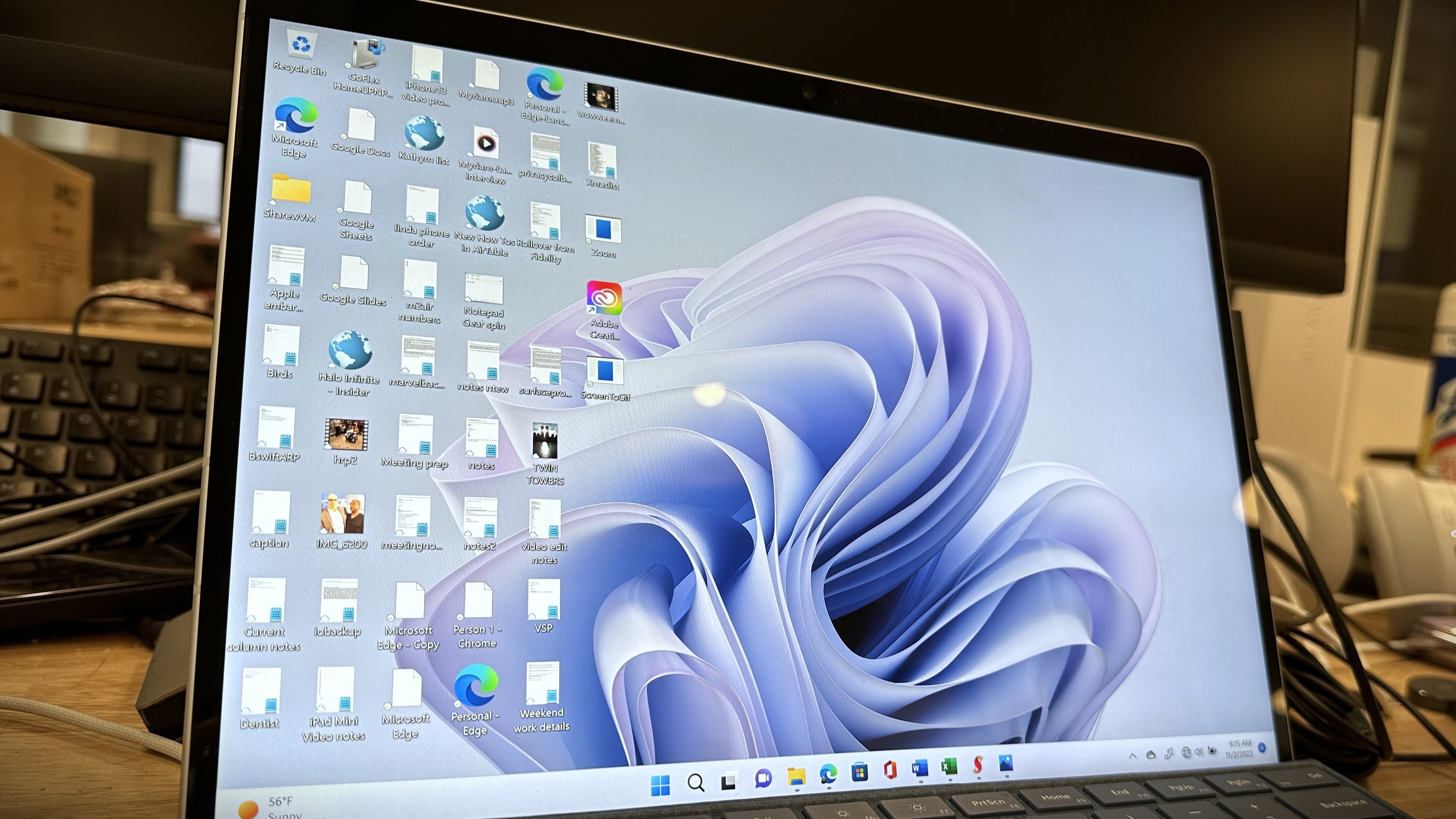
The news on Windows 11 running on the ARM-based SQ3 is mostly but not all good.
Microsoft's Surface Pro 9 5G is an excellent home for Windows 11, which is unsurprising considering that Microsoft designs both the platform and these computers. In general, it's a stable environment for the 37-year-old OS. However, there are some persistent reminders that Windows is not running on an Intel X86 platform.
During normal use, we encountered a number of bugs. Some were small (weird screen glitches) and others hampered our productivity. Microsoft's own Edge browser had a habit of crashing and wouldn't run smoothly until we rebooted our system. And, yes, we updated the OS.
More worrisome, though, was an Adobe Creative Cloud bug that is now preventing Adobe Photoshop CC 2023 from running on the Surface Pro 9 5G. When we looked up the bug on Google, we found that this was an issue first seen with the ARM-based Surface Pro X. It's disappointing that this issue has somehow carried over to Microsoft's latest SQ3-based Surface Pro 9.
Obviously, thin and light systems such as the Surface Pro might not be a creator's first choice and you may never personally run Adobe Photoshop on a Surface Pro 9 5G. However, we've been doing just that on Surface Pro devices for years, and think it's fair to expect that any system with the "Pro" name should be able to do so.
These are not deal breakers, as we were eventually able to stabilize Edge (it may have been a mid-review Edge update that did it) and there are other image editing options including Window's own Photos. Still, it's a reminder that this isn't your grandparents' Windows system with that trusty, always-compatible X86 underneath. Then again, ARM compatibility is a thousand times better than it was when Microsoft tried this with one of the earliest Surface systems and Windows RT.
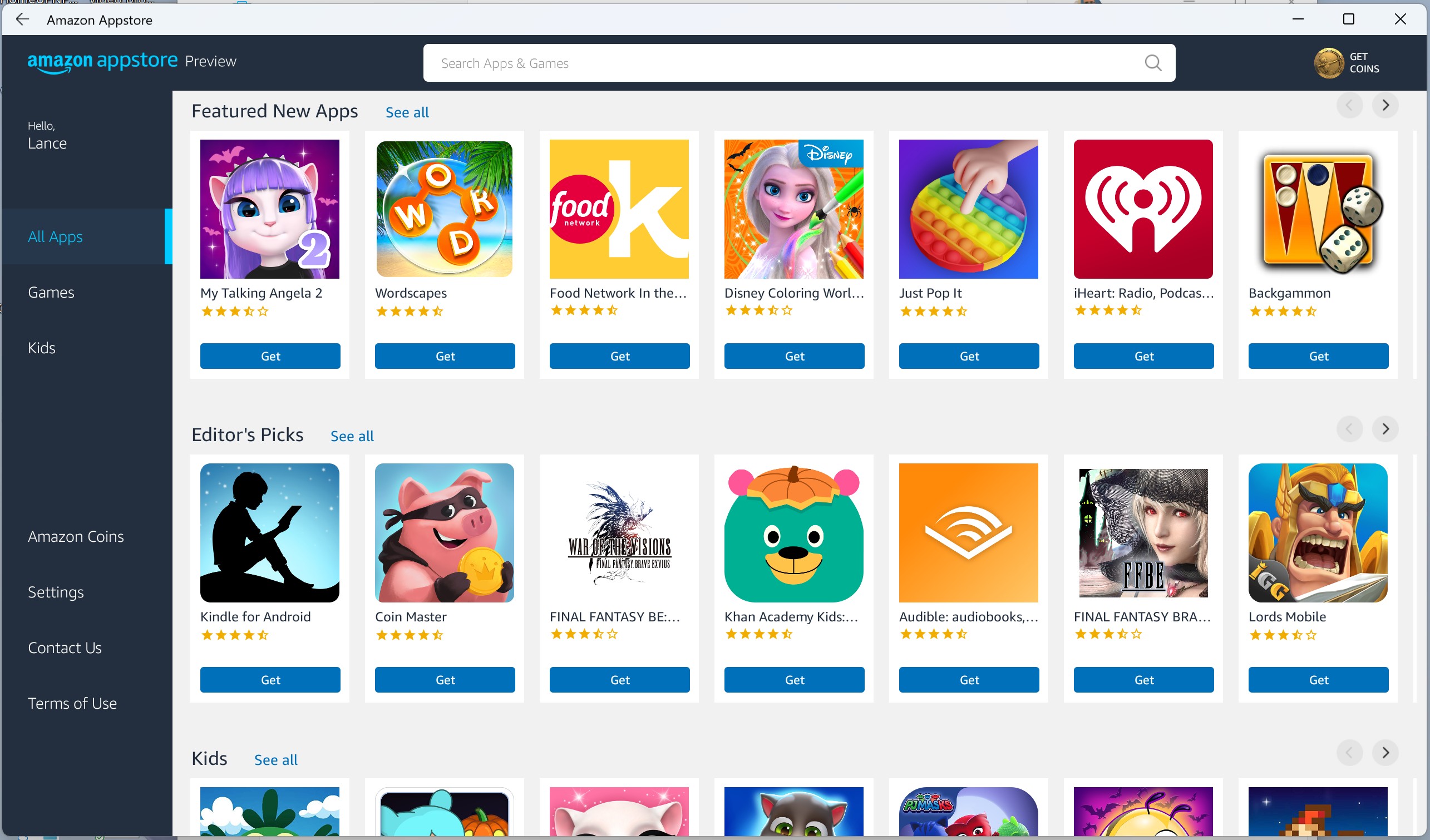
One benefit of having an ARM-based CPU is that you can easily run mobile apps on the desktop platform - you just have to choose from the Amazon App store's somewhat narrow list.
Microsoft has not given anyone a clear explanation for why we still can't get Google Play on its SQ3-based Surface. We have nothing against Amazon's App store, the same one you'll find on all its Fire Tablet devices, but it is not the full Android store.
To access these Android Apps, you have to run the awkwardly-named Windows Subsystem for Android. Fortunately, that only needs one activation and, after that, you go direct to Amazon App Store for the Android apps.
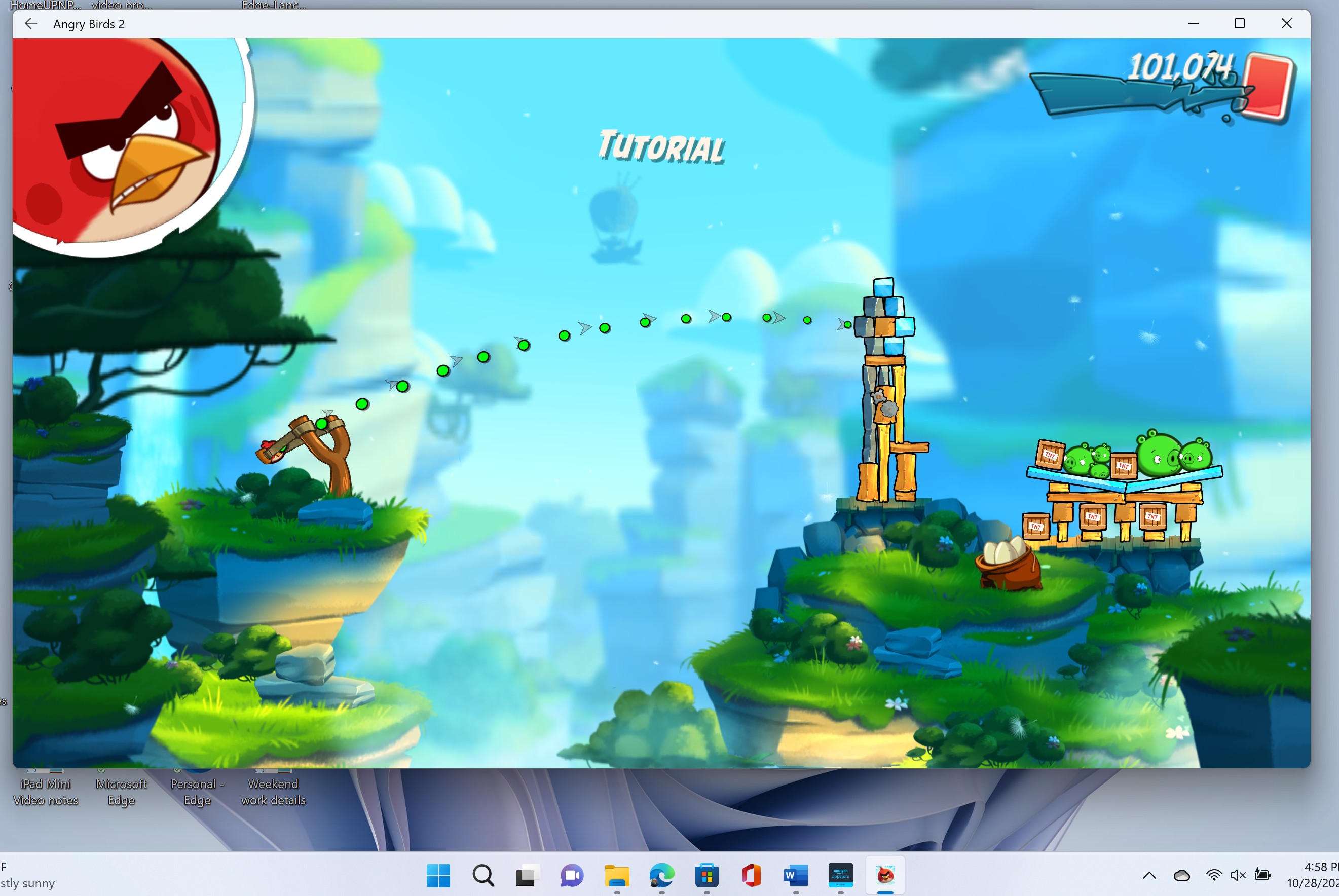
The App store takes almost a full minute to launch and the list of apps is mostly of the Candy Crush variety, However, we did find a few that we liked, including Among Us, Hill Climb Racing 2, and Angry Birds 2.
Game performance ranges from just OK to good. We saw some stuttering and had a few issues with audio (as in, no audio at all).
We did eventually get our games running smoothly and especially enjoyed tearing around and completing tasks in Among Us.
For now, the ability to run Android apps on a Windows platform remains little more than a curiosity, but that is set to change as Google Play Games is finally coming to Windows 11. It was not ready in time for this review, though.
- Windows 11: 3.5 / 5
Microsoft Surface Pro 9 5G: Performance and Battery
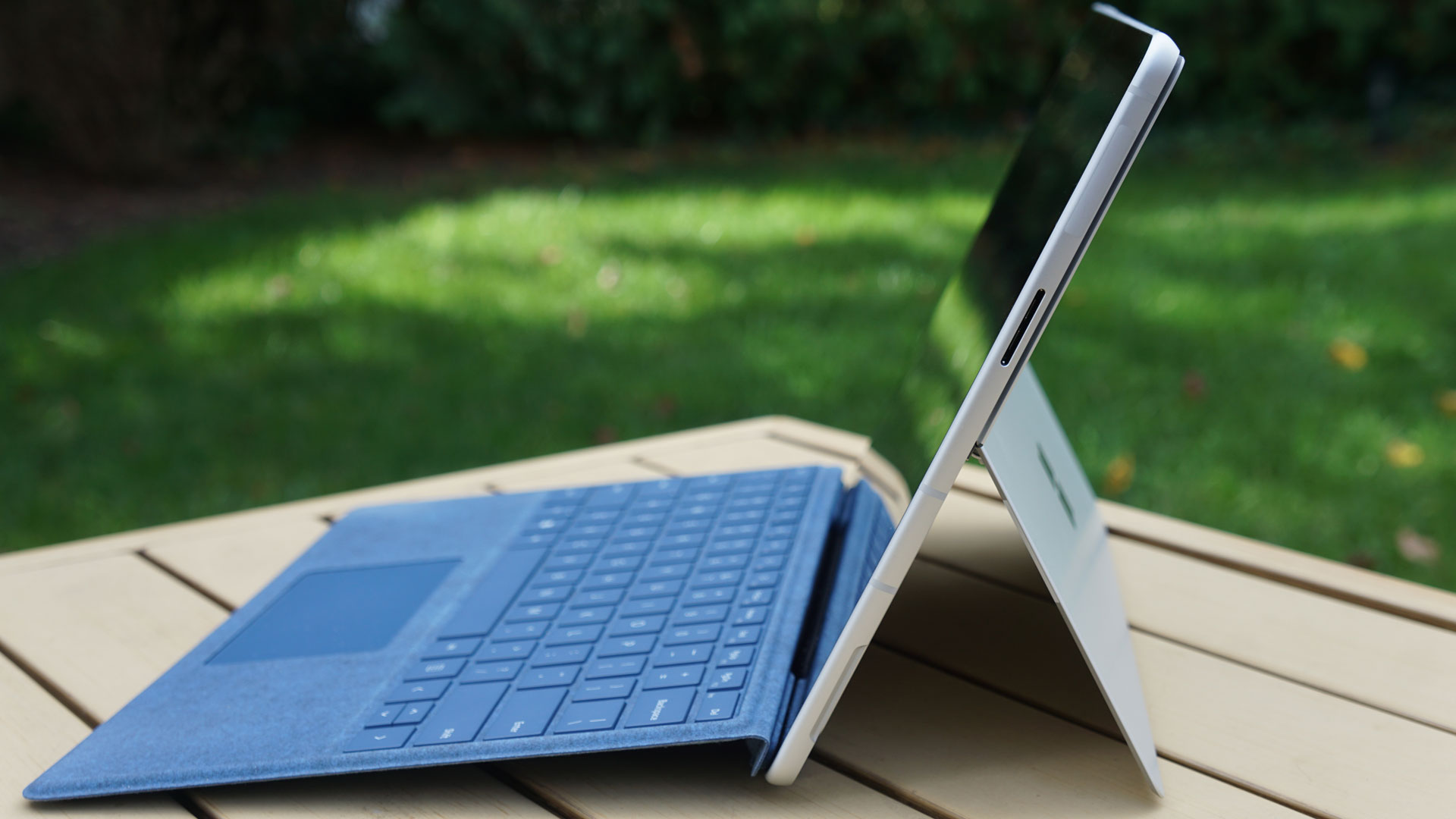
- Peppy
- Good for most laptop-grade tasks
- All-day battery life
Here's how the Microsoft Surface Pro 9 5G (2022) scored in our suite of benchmark tests:
3DMark Time Spy: 913; Fire Strike: 2,940; Night Raid: 13,013
GeekBench 5.4: 1,125 (single-core); 5,849 (multi-core)
Handbrake (ARM native): 12:58
Handbrake (ARM emulated): 8:40
Battery Life: 10 hours and 41 minutes
Despite the lack of full support for some of the PC world's most powerful apps, this is generally a well-performing system that never makes you feel like you're carrying a phone in PC's clothing.
We had multiple apps and many browser tabs open while driving a second HD screen and never saw a performance issue.
Benchmark numbers, especially on Geekbench, fall nearly in line with Apple's best mobile silicon, the A16 Bionic. As expected, the ARM-based system was bested across virtually all benchmarks save battery – where the Surface pro 9 5G got almost an hour more Wi-Fi-based web surfing. Microsoft promises 19 hours. Anecdotally, we got almost 16 hours of battery life with mixed-use. As always, your battery mileage will vary depending on core use.
As the 5G in the name denotes, the Microsoft Surface Pro 9 5G is always ready to connect. We didn't get a pre-paid plan for it and had no opportunity to test out its 5G capabilities. That said, we used it with a variety of WiFi networks and tethered it to our 5G phones. In all cases, it performed well.
- Performance and Battery: 4/ 5
If you put battery life and versatility at the top of your Windows 11 PC wishlist, there are few better-positioned systems than the Microsoft Surface Pro 9 5G.
It's a tablet with phone-like battery life and a touch screen. It's a big-screen laptop with exquisite Slim Pen 2 compatibility. It's a productivity maven when you pay that extra $279 for the Surface Signature Keyboard and Slim Pen 2 combo. It's got at least 10 hours of battery life (and maybe a lot more if you manage it right) and is ready to connect to your nearest 5G network.
Microsoft Surface Pro 9 5G: Report card
Should you buy a Microsoft Surface Pro 9 5G?
